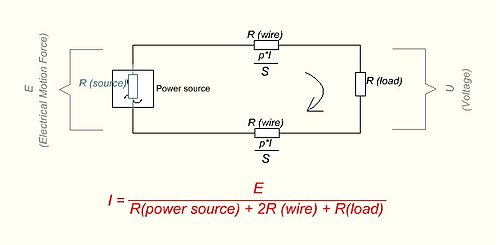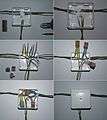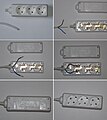User:Dmitry G/gallery/Electricity/Do-It-Yourself
Wiring for DIY'ers[edit]
*I'll not write long speeches about "culture of producing of works on electric installations". Decide yourself, can you do everything carefully like specialist and pass successfully inspection or not. Don't violate building codes in your region!. If you feel, that you can't do like specialist and inspector may differ your work from specialist's work - refuse from doing it and use specialist or other competent person! In name of Kirchhoff, Ohm and Edisson, Amen.
Tired of spending much money? Afraid to become victim of brianless specialists? Brits complain everywhere to brianless specialists, but their authorities do nothing to solve this problem, only useless calcing of the grated holes. Probably, they have lot of serious problems with providing of education, but I can't name exact reason. In Estonia (where I live) studing programs don't comply with the studied occupations; as result "fresh specialist" can't do anything in their trades after graduating. But low-quality education is quite profitable, so nobody sound the alarm about this fact.
Well, wiring is not so difficult as described everywhere and might be addictive, if everything goes good there. But you should follow all the codes in your region and take care about your own safety, cause electricity can kill you or others. As good specilists say, you should respect electricity instead putting a halter on it as cowboy.
- Step 1: To do some actions at electrical wiring, you should be 100% sure, what you're doing. If you have some little doubts, or you're not understanding what you do - keep this work to qualified specialst to avoid risk electrocute yourself.
- Step 2: In molest purposes, law limits any actions from 36VAC or 51VDC, where fuse/circuit breaker is more than 40A in many countries.
- So, don't get inside electricity meter's circuits, cause this work can be done only by workers from your energy company. As usual, all circuits before electricity meters are sealed mechanically by your energy company to limit access for "curious noses". Law requires there headliner (who has special education in electrical engineering and some experience), sometimes this headliner should have special license.
- As for circuits up to 40A, law recommends to do this work by specialist, but not requires in many countries. Let's see some simple DIY works, which are not requiring academic degree in electrical engineering and might be done using physics lessons from your schoolyears:
Result of improper DIY's work[edit]
Vikerlase 26, Tallinn[edit]
Wiring made by 82 years old granny, who decided to replace outdated equipment for her lazy grandson. So, if you don't know how to do it, don't do it at all. In such case better to ask help from qualified specialist.
Ümera 40, Tallinn[edit]
Wiring have been done by the worker "100 specialists in 1 person".
Introduction[edit]
Let's remember physics from your school. What is the current? It's directed flow of electrons. To supply this movement, the chain should form the closed circuit. So, electric load should have at least 2 poles and pass the current from one terminal to opposite through resistance. To supply power to your devices, it is required to have at least 2 wires. To have more ecocnomy, your energy company deliver to you alternating current (AC), where current replaces it's flow each 1/50 or 1/60 seconds. But to simplify, it's often said, that current flows from phase to neutral.
- One pole is "Phase" or "Live" and second one is "Zero" or "Neutral".
- Marking: modern European rules require brown with letter "L" to phase and blue with letter "N" to neutral.
- During Soviet era phase should have inscription "220/380" and neutral inscription "0".
- Marking: modern European rules require brown with letter "L" to phase and blue with letter "N" to neutral.
Safety[edit]
Some electric devices can't exist without metal cover. Metal cover means, that in case of wire's mastication, danger potential will "walk" on it's cover. TN system (zero is earthed) adds fuel to fire. If you are cooking and at the same time touching the sink, there forms potential difference between your hands and you get electric shock. It is quite rare lethal, but you will feel strong spasm in your muscles and quite often some pain.
To avoid it, wire rules require earthing to all metal parts, which are available to touch by human. If insulation of cable in your stove is damaged, there will exist short circuit, which beats out circuit breaker and nobody would get electric shock. But don't connect neutral and ground together!
-
Always keep in your head rule number one! Always remove the voltage before any actions!
-
Aren't you sure, that voltage is really missing? This test light costs only 4.80 EUR, but it can warn you against casual touching of voltaged area and electric shock.
-
How does electricity delivered to your home?
-
Color codes in single-phase devices; phase is brown and neutral is blue, sometimes there attempting yellow-green earthing wire.
Joining the wires[edit]
-
How to wire inside wet rooms
-
How to wire low-powered circuits outdoor
-
How to connect aluminium and copper properly
-
Explaining of proper AL-CU connection
-
How to join wires in US
-
Result of American twist nuts
-
Joining wires by luster terminals
-
How to join wires in Europe
-
Terminals for chandelier
-
How to join halogen lamps
-
Self-locking for low-power (<10A) circuits
Simple repairing of some home appliences[edit]
Where you can apply knowledges you had got from physics lessons while you were studing at school.
Doorbell wiring[edit]
There are 2 types of doorbells. One of them is direct and second is low voltage. Direct works from AC from your fuse box (110V in US and 230V in Europe). Second one is converting voltage from mains AC to safe 12V.
- How to choose? If you have doorbell with dielectric cover and button is installed inside building, use mains AC doorbell. But if the button is installed out of building, of course use low-voltage doorbell to avoid shocks in rainy weather; also ground wire doesn't required for 12V devices.
-
Doorbell with mains AC voltage
-
Low voltage doorbell
For low-voltage doorbell you need to install reducing transformer to your fuse box. In Europe you can use transformer for DIN rail, but in US you need to find some free space in fuse box for transformer and drill some holes for installing it. Or better to install big junction box with dielectric cover and put doorbell transformer inside it.
Schuko plug wiring[edit]
-
Wiring the plug (if the plug of your device is OK, but you don't want to buy new one due to little damage)
-
One more example
Power strips[edit]
-
Lesson 2 - add power strip to your construction and you'll get extension cord fully done by you!
-
Practical extension cord for your garage or attic
-
Selfmade extension cord for PC
Extension cords[edit]
-
Low-power load
-
Extension cord for your garden
Light applineces[edit]
I suppose, you'll not do this =)
-
Light switch is damaged in your favorite light fixture? You're going to throw it to the trash bin? No problem, replace damaged switch.
-
How does lampholder work?
-
How to install dimmer to your favorite lamp (NB! not valid for fluorescent lamps!)
-
Diagrams of light switches. I explain it on first lesson in vocation school and nobody feel problems with it.
Power connectors from variable home appliences[edit]
-
Your power cord from PC is working bad or sparking. Sometimes it happens, cause IEC 60320 connectors are not such flexible, as it required. New one cost 9 EUR or more, but see how to repair power cord in your PC spending only 3.65 EUR.
Outlets[edit]
Isn't everything is clear from previous lessons? Complicate your tasks.
-
Don't you feel youself more sure in electricity? Let's complicate your exercices. NB! Be extremely careful doing this work!
-
One more example of Schuko socket wiring
-
Your PC requires more outlets, than existing? Are you tired to use extension cords? Extensinsion cords making cable salad under your computer table? Let's solve this problem only in 7.03 EUR.
-
One more way to eliminate cable salad under your PC table. As for Americans, I may suggest them to install 3 or 4 usual outlets to wall near computer table, where master outlet will be GFCI and to power other outlets from master consistently (when you press "test" button on master, all outlets under your table should disenergise), as they usually have drywalls or wood walls and protect them by 5A circuit breaker.
-
Temporary socket for tools
-
Socket for air compressor (NB! 400 Volts! Wire it carefully, clamp firmly, put enough stripped wire area to terminals, use related circuit breaker, don't overload it, use through RCD, turn power on only after cover is installed!)
-
How to wire electric stove. NB! 400 Volts!
- Videos:
Fuse box[edit]
Sometimes you get to situation, when you buy new apartment in old house and it appears, that all rooms are protected by one or two old low-ampere fuses. Additionaly, wire gauges there is too thin and you have new problem with power cause it is not enough for using your electric applinces. If you increase fuse, you risk to have fire due to thin old wiring. How to solve this problem?
Total power carried to your home[edit]
Your energy company provides some power to your home, which are specified in your contract. So, don't try to replace main circuit breaker, which protects their electricity meter - to increase power there you should change contract with your energy company and seals could be removed/installed only by your energy company.
Power in rooms[edit]
But when total power is enough. In this case you should update electric equipment in your home. "Equipment" means, that you should replace whole wiring: wires, fuses, outlets and as usual light switches and junction boxes. As experience shows, it is better when you make new installations in parallel to already existing wiring and when everything is ready, you switch from old wiring to new wiring.
- In this case you disenergize main circuit breaker and connect your new wiring to wires, which are deduced from your energy meter; and better to do it through load switch. If there are also old thin wires, ask your energy company to connect your new wiring to their electricity meter. It is not expensive. But don't try to remove their seals from electricity meter or main circuit breaker yourself, cause it is illegal action. Finally you disconnect old wiring from electricity and remove it from your home.
Some countries requires specialist to do such works. But in fact there are no any difficult things, which requires any special knowledges. But I reccomend you to visit short studing for electrical works. It takes only 2 weeks, but you will have absolutely official paper, which allows you to do such works absolutely legally. Also, you'll save lot of money, cause only works without materials could cost 6000 EUR or more.
Teaching video about wiring in your home (subpanel with circuit breakers + outlet boxes)
Lets get known some things about fuse boxes:
-
Lesson 1 - lets find out, what is inside
-
Lesson 2 - desing circuits in your home and buy suitable panel products
-
Lesson 3 - how to wire circuit breakers.
-
Lesson 4 - little theory about power systems.
Then let's see how to assemble it (NB! Only if you really understand how to do it!!!):
-
Rule number one - safety first! Better to use separated box to load switch, cause lot of electricians casually touched load switches while working (it is very easy to hook it) and got shocks. But you can also use load switch inside big fuse box (as rules require), but it will be too risky to hook it casually by clothes or watches or something else and energise open metal parts, getting strong electic shock.
-
Choose correct place. No gas pipes (one more for Americans - no any gas pipes near fuse box, cause any spark and you'll takeoff to the air with your home), no explosives, no showers, no baths, no stoves, not fireplace near it. Place shouldn't be danger at all to use your fuse box.
-
Wire it according to wiring rules of your country. Circuit breakers and wire gauges should be chosen by it's power (light fixtures can contain thin wires and weak terminals, washing machine may require more power). Also, follow selective - if electricity meter is protected by "C"-type circuit breaker (5-10 In), your circuits should be protected by "B"-type circuit breakers (3-5 In). Otherwise any short circuit will beat out main circuit breaker at the same time with line circuit breaker.
-
After all circuits are connected to the circuit breakers and work is done, put the cover.
- NB! Don't forget to hide wires or cables in conduit or duct! Here I've finished work next day cause decorative ducts came to shop only next day.
- NB! Don't break bearing walls at all!!! It is danger for all house! Better to hide the wires or cables in decorative ducts.















































